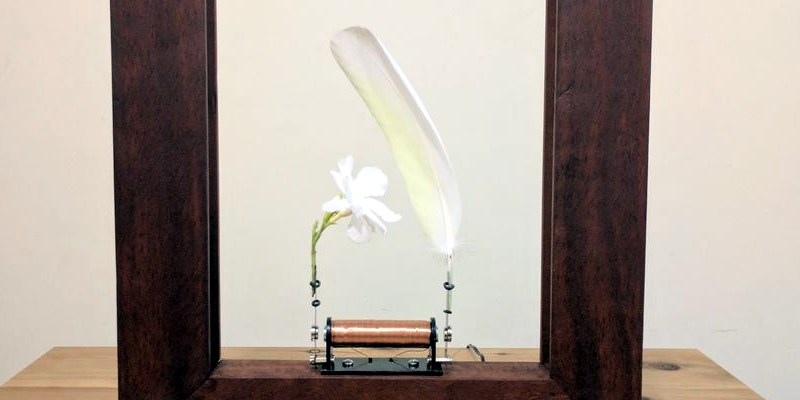[Paul] created a frame that uses an Arduino and LEDs to create a slow motion illusion of a delicate item (like a flower or a feather). The effect is striking as you can see in the video below.
[Paul] had seen similar projects (both one-offs and sold as a product), but wanted to do his own take on it. The principle is simple: The device vibrates the objects at one frequency and strobes LEDs at a slightly different frequency (80 and 79.5 Hz, in this case). The difference between the frequencies (the beat frequency) is what your eye perceives as a very slow (0.5 Hz, here) motion.
Once you know the secret behind the device, it is not very complicated to create. The woodworking for the frame is the bulk of the work. An Arduino excites an electromagnet to vibrate the subject items. It also pulses the LED strips to achieve the strobe effect. It’s simple, striking, and a show piece. It seems like everyone has been building their own magic mirror project, but we proffer this awesome concept as the next big thing everyone should try on their own workbench. Let’s check out a few other examples to get you thinking.
One of [Paul’s] inspirations was Time Frame, which appears in the second video, below. You can find its code on GitHub. It also uses an Arduino to create the same effect. The other inspiration was Slow Dance, which we covered earlier. We’ve also seen a similar trick played with water droplets.















This is a beautiful effect, and making one had somehow slipped off my list of things to do! Thanks for reminding me to get back in gear :)
(Yes, I’m too lazy to drill into the project – so if answered, I apologize. Reluctantly. Cause I’m Canadian. Sorry.)
80Hz. My brain instantly is thinking: BUZZZZZ! So, pretty to look at, but drive me nuts in 30 seconds flat if I have to listen to it.
Yes?
It looks like the studs are far enough away from the magnet to prevent contact, so the noise should be minimal. Would help to cast the magnet coils in epoxy to prevent noise in the turns.
You still have the oscillations in the flower and support mechanisms itself, which by the looks of it is pretty substantial.
So add some noise cancelling speakers.
Wouldn’t that convert the whole thing into a stasis frame?
You could use rubber or sponge or whatever to insulate the vibrating parts from the frame. Make sure the metal vibrating arm can’t touch the electromagnet. Should take care of most of it. It’s only necessary for the arm and flower to actually move, everything else can be damped. The arm is springy and flowers are soft. Should be possible to get it pretty quiet.
Build one myself using some Chinese electromagnet from E-Bay. As long as everything is fixed in place the frame operates almost silent.
There are no switch contacts like a buzzer so I would expect the noise to be minimal.
Very Cool.
Neat. Time to make a bobble head out of a tuning fork.
i am going to build one for my wife for valentines day. thank you very much
Nice! One more project on the todo-list.
Thanks everyone for your comments! Yes, it’s usually very quiet, although the screws connecting the spring steel to the base do loosen occasionally which makes it much louder. // TODO: Apply thread lock
Slick. So many old stroboscope ideas in the past… somehow this hadn’t occurred to me.
Bet it would be cool if you added UV leds.
It could flash every few seconds, the phosphorescent parts would pop out. I’d like to test something out, blacklight on some plants.
Hint: bees can see UV.
Ohh, awesome. Flowers have landing strips built right in!
Yup, lots of pollinating insects can see UV. Plants can look really interesting in the UV frequencies. Doesn’t necessarily mean they fluoresce, though, so unless you can actually see UV, illuminating stuff with it might not give much of a result.
Still it’ll impress the shit out of nerdy bees.
can i use just any e-magnet i have on my bench or do i need a specific one?
any will do, Just adjust the distance from the electro-magnet to the to the ferric component of the objects support so that I does not physically connect and that it does not have so much influence the object is shaken too forcefully. The resonant frequency of the object will be set by the distance from the base to the ferric component and also to a similar but lesser degree by the height of the object above the ferric component. Just play with it and you will see.
They’re all just variables that need to matched so try it with what you have but you don’t need to drive it hard because resonance will help.
Dumb Q, but if you are in a (single phase) fluorescent room, then do you need the frame? you just need to oscillate the coil to give the beat frequency? maybe a vibrating vase etc?
Some of the effects could be done with low persistence fixed frequency lighting like fluorescent by varying the physical oscillation frequency. However, many of the effects demonstrated would require physical shifting that’s not possible. It’s easy to change the LED lighting signals as they have no mass so they can be changed at will.
The pulses have to be very short, like any other strobe. That’s the key. Otherwise, with longer illumination periods, the image will average-out, smear, along the time axis. So you won’t get the series of little snapshots you get with a strobe light, you’ll just see a blurry flower.
Normal room illumination is lit most of the time, the gaps between are short, the lit period long. Exactly the opposite of what you’d need.
Very nice effect, i want try !